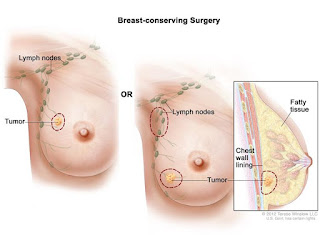TOP TEN HEALTH THREATS FOR WOMEN AND HOW TO PREVENT IT

1. Heart disease
-
This
is the leading killer of both men and women in Malaysia, accountable for about
one third of all deaths.
-
The
common symptoms of heart disease are: pain or numbness in the chest, back,
shoulder, arm or jaw; shortness of breast with little or without exertion,
nausea, dizziness, palpitation
How to
avoid it:
-
Modify
your risk factors by choosing a healthy lifestyle, including a healthy balanced
diet, quit smoking, regular exercise (aim for at least 30 minutes of
moderate-intensity activity e.g. brisk walking at least 5 days a week)
2.
Breast cancer
-
Risk
factors for breast cancer including increasing age, positive family history/
genes, past exposure to radiation, prolonged usage of hormonal replacement
therapy and oral contraceptive pills, obesity, alcohol intake, diet high in
saturated fat and lack of exercise.
-
Symptoms
of breast cancer including hard lump, change in the size or shape of a
breast, skin dimpling, nipple turning in (becoming inverted), blood stained
nipple discharge and abnormal rash around the nipple areola region
How to avoid:
-
Recommended mammogram screening at 40 years old and above,
starts earlier if there is high risk family history
-
Eat a healthy balanced diet and be physically active
-
Don’t smoke
-
Limit alcohol intake
-
Breastfeeding more than 2 years
 3. Menopausal symptoms
3. Menopausal symptoms
-
The
menopause is a normal part of life; it is not a disease or a condition.
Even though it is the time of the woman's last period, symptoms may begin many
years earlier.
-
The most common symptoms are hot flushes and
night sweats. Some women may also experience insomnia, incontinence and
changes to their mood and sex drive.
How to avoid:
-
Unless symptoms are severe, changes in lifestyle and diet
might be all that is needed to deal with the symptoms
-
Hot flushes and night sweats usually improves with regular
exercise.
-
Sleep disturbance ca be helped by going to bed and get up at the same time each
day, cutting out caffeine and learn
relaxation techniques
-
Vaginal
discomfort and dryness improves with vaginal lubricants and maintaining
sexually active
 4.
Obesity
4.
Obesity
-
Women with a higher degree of abdominal obesity are
especially susceptible to type 2 diabetes, and diabetic women have
disproportionally higher relative risk of coronary heart disease.
-
Monitoring changes in waist circumference over time can
provide an estimate of changes in abdominal fat even in the absence of changes
in weight. Women are at increased disease risk if they have a waist
circumference > 35 inches (88 cm)
How to
avoid
-
Body weight is primarily determined by the critical balance
between energy intake and energy expenditure, an obese person's energy balance
over 24 hours has to be negative in order to lose weight. This can be achieved
by decreasing total energy intake or increasing physical activity or both.
-
Diet and lifestyle modification is widely considered the
primary means to control weight. It is also the most important approach for
diabetes prevention
 5.
Reproductive & maternal health
5.
Reproductive & maternal health
-
Fertility
and pregnancy health are extremely important for women who wish to become
mothers.
-
Many
women experience difficulty in conceiving and pregnancy related complications,
which are distressing. Fertility decreases with advancing women age.
How to
avoid:
-
Seek
professional medical help early.
-
In
order to identify the problem, fertility testing (husband and wife) may be
needed to before suitable fertility treatment is advised. Preconception counselling
and health education are important. Always communicate with the care provider
regarding labour planning to personalize care to fit the individual need
-
Nearly
70% of osteoporosis sufferers are women. You are never too young or old to take care of your
bones.
-
Good lifestyle habits can help you protect your bones and
decrease your chance of getting osteoporosis.
How to
avoid:
-
Get enough calcium and vitamin D, and eat a well-balanced
diet.
-
Exercise
-
Don’t smoke or drink

7.
Cervical cancer
-
Cervical cancer is the second most common type of cancer for women
worldwide, but it is also one of the most
preventable cancer.
-
Cancer of the cervix tends to occur during midlife. Half of
the women diagnosed with the disease are between 35 and 55 years of age. It
rarely affects women under age 20, and approximately 20 percent of diagnoses
are made in women older than 65.
-
Human papillomavirus (HPV) is found in about 99% of cervical
cancers. Precancerous cervical
cell changes and early cancers of the cervix generally do not cause symptoms. Possible
symptoms of more advanced disease include abnormal or irregular vaginal bleeding,
pain during sex, or vaginal discharge
How to avoid :
-
Regular Pap smear is the best way to find cervical cell changes that can
lead to cervical cancer. Pap smear should begin at age 21. Routine screening is
recommended every three years for women ages 21 to 65.
-
If you are age 26 or younger, you can get the HPV vaccination which protects against types of HPV that cause most
cases of cervical cancer.
8.
Depression
-
Pregnancy, the
postpartum period, perimenopause, and the menstrual cycle are all associated
with dramatic physical and hormonal changes. Depression can present as persistent
sad, anxious, or “empty” mood, feelings of hopelessness or worthlessness,
fatigue, insomnia, loss of interest and pleasure in activities, appetite and/
or weight change and suicidal ideation.
How to avoid:
-
Even the most
severe cases of depression can be treated. Try talking to your partner and
family. Depression is commonly treated with medication, psychotherapy (where a
person talks with a trained professional about his or her thoughts and
feelings; sometimes called “talk therapy”), or a combination of the two.

9.
Incontinence
-
Pregnancy,
childbirth, and menopause may
contribute to urinary incontinence in women. Weak bladder muscles, overactive
bladder muscles, and nerve damage may also cause urinary
incontinence in women.
-
This is a
very common and treatable problem, but a lot of women just bear with it
without seeking for medical help
How to avoid:
-
First , see a urologist or gynaecologist.
-
The treatment
of urinary incontinence include medication,
behavioral or nonpharmacologic treatments eg. bladder training and Kegel
exercises, biofeedback and neuromodulation. Surgery may be needed for more
severe cases.

10.
Violence against women
-
Violence strikes
women from all kinds of backgrounds and of all ages. It can happen at work, on
the street, or at home.
-
Sometimes, women
are attacked by strangers, but most often they are hurt by people who are close
to them, such as a husband or partner. Violence and abuse can have terrible physical
and emotional effects on women.
How to
avoid
-
Prevention
should start early in life, by educating and working with young boys and girls
promoting respectful relationships and gender equality
-
Sometimes a
relationship might not be abusive, but it might have some serious problems that
make it unhealthy. If you think you might be in an unhealthy relationship, you
should be able to talk to your partner about your concerns. If you feel like
you can't talk to your partner, try talking to a trusted friend, family member,
or counsellor.
-
Do
not be afraid to stand up for yourself.




Comments
Post a Comment